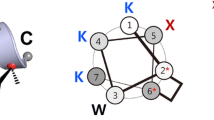Abstract
We previously reported a series of amphipathic helices of stapled heptapeptides as membrane-lytic antimicrobial peptides. These peptides possess three lysine residues as the sole cationic amino acid residues in their hydrophilic face of the helix. Lysine-to-arginine substitution is often shown to increase antimicrobial activity of many natural AMPs due to the more favorable interactions of guanidinium moiety of arginine with membranes. In an effort to further improve the pharmacological properties of our novel AMP series, we here examined the impact of lysine-to-arginine substitution on their structures and antimicrobial and hemolytic activities. Our results indicate that the lysine-to-arginine substitution does not always guarantee enhancement in the antimicrobial potency of AMPs. Instead, we observed varied potency and selectivity depending on the number of substitutions and the positions substituted. Our results imply that, in the given helical scaffold stabilized by a hydrocarbon staple, antimicrobial potency and selectivity are influenced by a complex effect of various structural and chemical changes accompanied by lysine-to-arginine substitution rather than solely by the type of cationic residue. These data show potential for use in our scaffold-assisted development of short, selective, and metabolically stable AMPs.



Similar content being viewed by others
References
Arias M, Piga KB, Hyndman ME, Vogel HJ (2018) Improving the activity of Trp-rich antimicrobial peptides by Arg/Lys substitutions and changing the length of cationic residues. Biomolecules. https://doi.org/10.3390/biom8020019
Bhattacharya S, Zhang H, Debnath AK, Cowburn D (2008) Solution structure of a hydrocarbon stapled peptide inhibitor in complex with monomeric C-terminal domain of HIV-1 capsid. J Biol Chem 283(24):16274–16278
Chen Y-H, Yang J-T, Martinez HM (1972) Determination of the secondary structures of proteins by circular dichroism and optical rotatory dispersion. Biochemistry 11:4120–4131
Dinh TTT, Kim D-H, Lee B-J, Kim Y-W (2014) De novo design and their antimicrobial activity of stapled amphipathic helices of heptapeptides. Bull Korean Chem Soc 35:3632–3636
Dinh TTT, Kim D-H, Nguyen TQ, Lee B-J, Kim Y-W (2015) N-Capping effects of stapled heptapeptides on antimicrobial and hemolytic activities. Bull Korean Chem Soc 36:2511–2515
Huang Y, Huang J, Chen Y (2010) Alpha-helical cationic antimicrobial peptides: relationships of structure and function. Protein Cell 1:143–152
Jiang Z, Vasil AI, Hale JD, Hancock REW, Vasil ML, Hodges RS (2008) Effects of net charge and the number of positively charged residues on the biological activity of amphipathic α-helical cationic antimicrobial peptides. Pept Sci 90:369–383
Jorgensen JH, Ferraro MJ (1998) Antimicrobial susceptibility testing: general principles and contemporary practices. Clin Infect Dis 26:973–980
Kim Y-W, Verdine GL (2009) Stereochemical effects of all-hydrocarbon tethers in i, i + 4 stapled peptides. Bioorg Med Chem Lett 19:2533–2536
Kim Y-W, Grossmann TN, Verdine GL (2011) Synthesis of all-hydrocarbon stapled [alpha]-helical peptides by ring-closing olefin metathesis. Nat Proc 26:761–771
Li L, Vorobyov I, Allen TW (2013) The different interaction of lysine and arginine side chains with lipid membranes. J Phys Chem B 117:11906–11920
Lohner K, Sevcsik E, Pabst G (2008) Liposome-based biomembrane mimetic systems: Implications for lipid-peptide interactions. In: Liu AL (ed) Advances in planar lipid bilayers and liposomes, vol 6, 1st edn. Elsevier, Waltham, pp 103–132
Luong HX, Kim D-H, Lee B-J, Kim Y-W (2016) Antimicrobial and hemolytic activity of stapled heptapeptide dimers. Bull Korean Chem Soc 37:1199–1203
Luong HX, Kim D-H, Mai NT, Lee B-J, Kim Y-W (2017) Mono-substitution effects on antimicrobial activity of stapled heptapeptides. Arch Pharm Res 40:713–719
Marr AK, Gooderham WJ, Hancock REW (2006) Antibacterial peptides for therapeutic use: obstacles and realistic outlook. Curr Opin Pharmacol 6:468–472
Nguyen LT, de Boer L, Zaat SA, Vogel HJ (2011) Investigating the cationic side chains of the antimicrobial peptide tritripticin: hydrogen bonding properties govern its membrane-disruptive activities. Biochim Biophys Acta 1808:2297–2303
Phillips C, Roberts LR, Schade M, Bazin R, Bent A, Davies NL, Moore R, Pannifer AD, Pickford AR, Prior SH, Read CM, Scott A, Brown DG, Xu B, Irving SL (2011) Design and structure of stapled peptides binding to estrogen receptors. J Am Chem Soc 133(25):9696–9699
Schafmeister CE, Po J, Verdine GL (2000) An all-hydrocarbon cross-linking system for enhancing the helicity and metabolic stability of peptides. J Am Chem Soc 122:5891–5892
Schmidt NW, Wong GCL (2013) Antimicrobial peptides and induced membrane curvature: geometry, coordination chemistry, and molecular engineering. Curr Opin Solid State Mater Sci 17:151–163
Shai Y (2002) Mode of action of membrane active antimicrobial peptides. Biopolymers 66:236–248
Verdine GL, Hilinski GJ (2012) Stapled peptides for intracellular drug targets. Methods Enzymol 503:3–33
Yeaman MR, Yount NY (2003) Mechanisms of antimicrobial peptide action and resistance. Pharmacol Res 55:27–55
Zhang H, Zhao Q, Bhattacharya S, Waheed AA, Tong X, Hong A, Heck S, Curreli F, Goger M, Cowburn D, Freed EO, Debnath AK (2008) A cell-penetrating helical peptide as a potential HIV-1 inhibitor. J Mol Biol 378(3):565–580
Acknowledgements
This work was supported by the Basic Research Program through the National Research Foundation of Korea (NRF) Grant funded by the Korea government (MSIT) (2015R1D1A1A01060265).
Author information
Authors and Affiliations
Corresponding author
Ethics declarations
Conflict of interest
The authors declare no conflict of interest.
Rights and permissions
About this article
Cite this article
Luong, H.X., Kim, DH., Lee, BJ. et al. Effects of lysine-to-arginine substitution on antimicrobial activity of cationic stapled heptapeptides. Arch. Pharm. Res. 41, 1092–1097 (2018). https://doi.org/10.1007/s12272-018-1084-5
Received:
Accepted:
Published:
Issue Date:
DOI: https://doi.org/10.1007/s12272-018-1084-5




